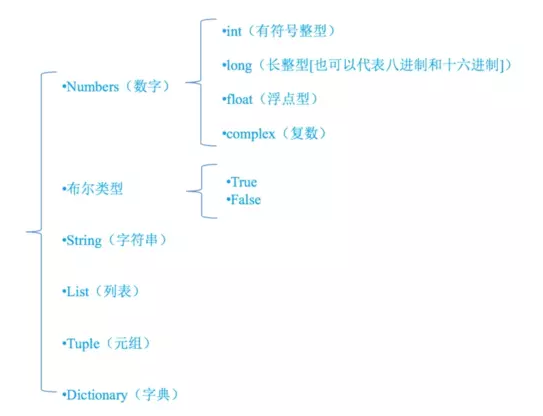
python内置的数据类型

Python3.7内置的关键字
['False', 'None', 'True', 'and', 'as', 'assert', 'async', 'await', 'break', 'class', 'continue', 'def', 'del', 'elif', 'else', 'except', 'finally', 'for', 'from', 'global', 'if', 'import', 'in', 'is', 'lambda', 'nonlocal', 'not', 'or', 'pass', 'raise', 'return', 'try', 'while', 'with', 'yield']
格式化输出
A = 'dog'
print('It is a %s' % A ) # --> It is a dog
# 格式符可以是 %d整数 %f浮点数
print('%06d'% 1111) #-->001111 # 拿0补全6位,不写0就是拿空格补全6位
print('%.3f' %1.2) #-->1.200 # 保留3位小数
print('It is a {}'.format(A) ) # --> It is a dog关于format函数还可以设置参数,传递对象:format多种用法
逻辑运算符优先级and or not
当not和and及or在一起运算时,优先级为是not>and>or
字符串常见操作
find
检测 str 是否包含在 mystr中,如果是返回开始的索引值,否则返回-1
mystr.find(str, start=0, end=len(mystr))
index
跟find()方法一样,只不过如果str不在 mystr中会报一个异常.
mystr.index(str, start=0, end=len(mystr))
count
返回 str在start和end之间 在 mystr里面出现的次数
mystr.count(str, start=0, end=len(mystr))
replace
把 mystr 中的 str1 替换成 str2,如果 count 指定,则替换不超过 count 次.
mystr.replace(str1, str2, mystr.count(str1))
split
以 str 为分隔符切片 mystr,如果 maxsplit有指定值,则仅分隔 maxsplit 个子字符串
mystr.split(str=" ", 2)
capitalize
把字符串的第一个字符大写
mystr.capitalize()
title
把字符串的每个单词首字母大写
>>> a = "hello world" >>> a.title() 'Hello world'
startswith
检查字符串是否是以 hello 开头, 是则返回 True,否则返回 False
mystr.startswith(hello)
endswith
检查字符串是否以obj结束,如果是返回True,否则返回 False.
mystr.endswith('.jpg')lower
转换 mystr 中所有大写字符为小写
mystr.lower()
upper
转换 mystr 中的小写字母为大写
mystr.upper()
ljust
返回一个原字符串左对齐,并使用空格填充至长度 width 的新字符串
mystr.ljust(width)
rjust
返回一个原字符串右对齐,并使用空格填充至长度 width 的新字符串
mystr.rjust(width)
center
返回一个原字符串居中,并使用空格填充至长度 width 的新字符串
mystr.center(width)
lstrip
删除 mystr 左边的空白字符
mystr.lstrip()
rstrip
删除 mystr 字符串末尾的空白字符
mystr.rstrip()
strip
删除mystr字符串两端的空白字符
>>> a = "\n\t hello \t\n" >>> a.strip() 'hello '
字典
查找元素
a = {'a':1}
print(a.setdefault('b', 2)) # --> 2 # 找不添加到字典中
print(a.get('c')) # --> None # 找不到不报错
print(a) # --> {'a': 1, 'b': 2}删除元素
a = {'a': 1, 'b': 2}
del a['a'] # 删除指定key
del a # 删除整个字典在内存里清除
clear a # 清空字典,a={}字典常见操作
dict.len()
测量字典中,键值对的个数
dict.keys()
返回一个包含字典所有KEY的列表
dict.values()
返回一个包含字典所有value的列表
dict.items()
返回一个包含所有(键,值)元祖的列表
python内置函数
max() 返回元素
min() 返回最小元素
len(容器)
del(变量) 删除变量
map(function, iterable, ...)
根据提供的函数对指定序列做映射
reduce(function, iterable[, initializer]) # initializer是初始参数
对参数序列中元素进行累积
filter(function, iterable)
用于过滤序列,过滤掉不符合条件的元素,返回由符合条件元素组成的迭代器对象(py3)。py2返回列表。








